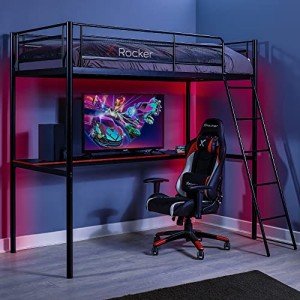The Ultimate Guide to Kids Bunk Beds: Maximizing Space and Fun
With the rise of vertical living and smaller sized areas, the appeal of bunk beds has skyrocketed among families. Bunk Beds Store provide a useful sleeping service, particularly in shared rooms, but they likewise bring an element of enjoyable into a kid's life. This detailed guide explores the features, benefits, and factors to consider of kids' bunk beds, making it much easier for moms and dads to choose the right bed for their kids.
Functions of Kids Bunk Beds
Bunk beds are flexible furniture pieces that serve more than a single function. Here are some key functions to consider:
| Feature | Description |
|---|---|
| Product | Bunk beds can be constructed from wood, metal, or a mix of both, providing differing levels of durability and style alternatives. |
| Safety Features | A lot of bunk beds come geared up with guardrails, safe ladders, and topped supports for safety, especially important for young kids. |
| Design Variety | Choices range from classic designs to contemporary styles, guaranteeing a match for any room design. |
| Space-Efficiency | Bunk beds utilize vertical space, making them perfect for smaller sized rooms. |
| Convertible Options | Some models can be transformed into 2 different beds, supplying flexibility as children grow. |
| Storage Solutions | Some bunk beds include integrated storage drawers or shelves, helping to keep the room arranged. |
Advantages of Kids Bunk Beds
Purchasing a bunk bed comes with numerous advantages:
- Space Saving: Bunk beds make the most of flooring space, enabling more backyard or storage solutions.
- Fun Factor: With a bunk bed, kids have a location that fosters imagination and friendship during slumber parties or playdates.
- Economical: Instead of buying two different beds, a bunk bed can accommodate two kids simultaneously, saving cash in the long run.
- Versatility: Many bunk beds can be disassembled or transformed into twin beds, making them a long-lasting investment as kids's needs alter.
- Social Interaction: Bunk beds encourage family bonding and friendships, supplying an inviting space for kids to share stories and laughter.
Considerations When Choosing a Kids Bunk Bed
When picking the perfect bunk bed for a kid, parents ought to consider numerous factors:
- Safety Standards: Ensure that the bunk bed adhere to security guidelines and comes with vital security features.
- Age Appropriateness: Different designs deal with different age. For example, standard bunk beds might not appropriate for younger children.
- Room Dimensions: Measure the bedroom to guarantee the bunk bed fits properly, permitting space to walk around easily.
- Weight Capacity: Consider the weight load of each bed and guarantee it accommodates the kid's weight easily.
- Design Preferences: Letting children take part in the selection procedure can help them feel more fired up about their brand-new bed.
Kinds Of Kids Bunk Beds
Bunk beds are available in different styles and configurations to match numerous needs:
| Type | Description |
|---|---|
| Requirement Bunk Bed | A traditional style with one bed stacked on top of another, generally utilizing a ladder to access the top bunk. |
| L-Shaped Bunk Bed | Functions two bunk beds linked in an L-shape, frequently more large and suitable for kids sharing a space but requiring a bit more space. |
| Triple Bunk Bed | Makes up 3 stacked beds, suitable for optimizing sleeping plans in very limited spaces. |
| Loft Bed | A raised bed with space underneath that can function as a play location, study corner, or extra storage. |
| Futon Bunk Bed | Integrates a bunk bed on the top with a futon or sofa beneath, making it great for sleepovers and taking full advantage of room use. |
| Convertible Bunk Bed | Can be separated into 2 private beds, offering flexibility as children's needs change. |
Caring for Kids Bunk Beds
Preserving bunk beds is crucial for guaranteeing longevity and safety. Here are some easy care practices:
- Regular Inspections: Check the bed routinely for loose screws and tightened up bolts to guarantee stability.
- Cleanliness: Keep bed linen tidy and fresh, turning mattresses for even use.
- Guardrails: Ensure guardrails are safe and in location, specifically if kids tend to move around a lot in their sleep.
- Air Circulation: Ensure the bed has adequate air flow, preventing wetness buildup that can cause mold or mildew.
FAQs About Kids Bunk Beds
Q1: At what age can a kid securely utilize a bunk bed?
A1: Generally, kids aged 6 and older are thought about safe to utilize the upper bunk due to the height and stability elements included.
Q2: Can I put a bunk bed near a window?
A2: It is suggested to avoid putting a bunk bed near windows to lower the threat of falling or injuries.
Q3: Are bunk beds safe for more youthful children?
A3: While some modern-day bunk beds come with security functions accommodating younger children, it is normally recommended to wait until they are older, normally over six years.
Q4: What is the common weight limitation for top bunks?
A4: Weight limits differ by design but normally range from 150 to 250 pounds. Always describe the producer's specs.
Q5: How often should I inspect the bunk bed's safety functions?
A5: It is a good idea to conduct a safety check every few months or whenever you observe any indications of wear.
Kids' bunk beds work as a tactical option for families aiming to optimize space while supplying a fun and appealing sleeping environment for their kids. With a variety of alternatives offered-- from basic styles to loft beds-- parents have the liberty to choose something that fulfills their household's particular needs. By considering important factors such as security, space viability, and their kids's choices, moms and dads can make an informed option, ensuring that each child is delighted about bedtime while benefiting from a well-organized room.

